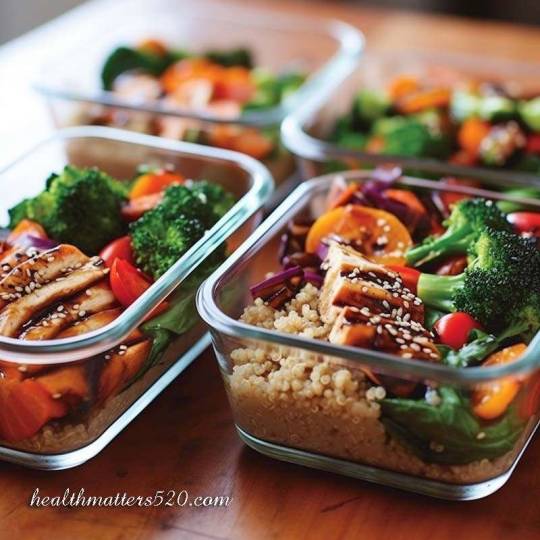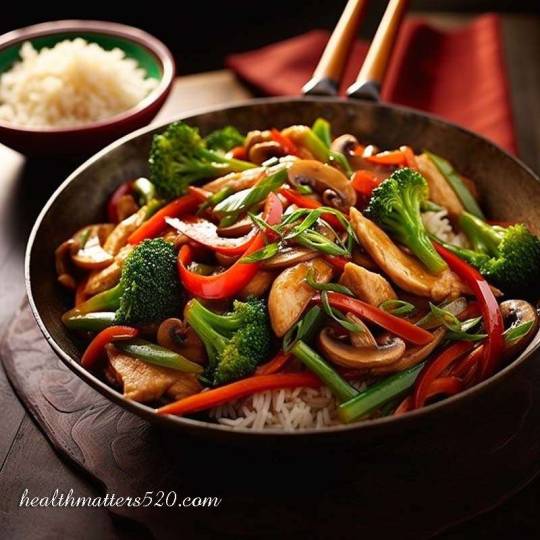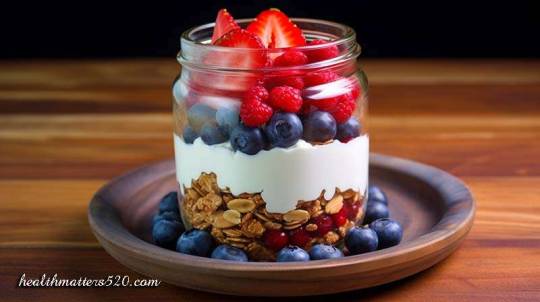#nutritioussnackanddessertideasformealprep
Explore tagged Tumblr posts
Text
Easy and Healthy Meal Prep Ideas for Weight Loss: A Complete Guide

Are you constantly struggling to find time to cook healthy meals, leaving you vulnerable to unhealthy food choices and hindering your weight loss goals? What if there was a simple and efficient way to ensure you have nutritious meals ready to go whenever hunger strikes? Enter meal prepping – a game-changing strategy that can revolutionize your approach to eating and help you achieve your weight loss aspirations. Picture this: you come home after a long day, tired and famished. Instead of resorting to takeout or reaching for unhealthy snacks, you open your fridge to find a neatly organized array of pre-portioned, wholesome meals, ready to be enjoyed. With just a little upfront investment of time and planning, meal prepping can provide you with a week's worth of healthy options that support your weight loss journey. In this comprehensive guide, we will explore the world of easy and healthy meal prep ideas designed specifically for weight loss. Whether you're a busy professional, a parent on the go, or someone seeking a convenient way to nourish your body while shedding pounds, this guide is your roadmap to success.

Interesting Statistics
Here are some interesting statistics related to meal prep and its impact on various aspects of life: Time-Saving Benefits: - According to a survey conducted by the International Food Information Council (IFIC), 60% of American adults who meal prep reported saving time during the week by planning and preparing meals in advance. Health and Nutritional Benefits: - Individuals who engaged in meal planning and preparation at home had healthier dietary habits, including increased fruit and vegetable consumption. - Those who frequently cooked at home consumed fewer calories, on average, compared to those who cooked less often or relied on eating out. Weight Management Benefits: - Adults who frequently engaged in meal planning and preparation had a healthier body weight and were more likely to meet dietary guidelines. - Meal planning and preparation were associated with better weight management outcomes, including reduced body mass index (BMI) and improved overall diet quality. Financial Benefits: - The American Dietetic Association estimates that meal planning and preparation at home can save an average of $9-$16 per meal compared to eating out. Food Waste Reduction: - One-third of all food produced for human consumption is wasted globally. Meal prepping can help reduce food waste by utilizing ingredients efficiently and repurposing leftovers.
Understanding the Basics of Meal Prepping
Meal prepping is a practical and effective approach to ensure you have healthy, portion-controlled meals readily available throughout the week. By investing a little time and effort upfront, you can save valuable minutes during busy weekdays and make consistent progress towards your weight loss goals. In this section, we will delve into the fundamental aspects of meal prepping, providing you with a solid foundation to get started on your journey. What is meal prepping? Meal prepping involves planning, preparing, and packaging meals in advance, typically for a few days or an entire week. It goes beyond simply cooking in bulk; it involves thoughtful consideration of your nutritional needs and goals. By dedicating a specific time each week to prepare your meals, you can take control of your nutrition and eliminate the need for impulsive, unhealthy food choices. Why is meal prepping effective for weight loss? - Portion control: Meal prepping allows you to portion out your meals in advance, ensuring you consume appropriate serving sizes. This helps prevent overeating and promotes a calorie deficit, which is crucial for weight loss. - Nutritional balance: When you meal prep, you can carefully select nutrient-dense ingredients and create well-balanced meals that provide the necessary macronutrients (protein, carbohydrates, and fats) and micronutrients (vitamins and minerals) your body needs for optimal health and weight management. - Reduced temptation: By having nutritious meals readily available, you reduce the temptation to reach for unhealthy options or indulge in impulsive snacking. Meal prepping empowers you to make mindful choices that align with your weight loss goals. How to get started with meal prepping? - Plan your meals: Begin by deciding which meals you want to prep for the week. Consider your schedule, dietary preferences, and nutritional requirements. Aim for a variety of proteins, whole grains, fruits, vegetables, and healthy fats to ensure a well-rounded diet. - Create a grocery list: Based on your meal plan, make a detailed grocery list of all the ingredients you'll need. This helps streamline your shopping trip and ensures you have everything on hand when it's time to cook. - Set aside dedicated prep time: Designate a specific day or time each week for meal prepping. This helps establish a routine and ensures you prioritize this important aspect of your health and weight loss journey. - Choose appropriate storage containers: Invest in a selection of durable, appropriately sized containers that are freezer-safe and microwave-friendly. This allows for easy storage, reheating, and portion control. - Cook and assemble: Follow your meal plan and prepare your meals in bulk. Cook proteins, grains, and vegetables, and then portion them out into your chosen containers. Make sure to label and date each meal for easy identification. By understanding the basics of meal prepping and implementing a systematic approach, you can take control of your nutrition and set yourself up for weight loss success.
Key Considerations for Healthy Meal Prep
Successful meal prepping for weight loss goes beyond simply cooking and portioning meals. It requires careful consideration of your specific goals and nutritional needs. Setting weight loss goals - Define your objectives: Begin by setting clear and realistic weight loss goals. Determine how much weight you want to lose and the timeframe in which you aim to achieve it. Remember to set achievable targets that prioritize long-term sustainability over quick fixes. - Consult with a healthcare professional: If you have specific dietary requirements or health concerns, it's advisable to consult with a registered dietitian or healthcare professional. They can help tailor your meal plan to your individual needs and ensure it aligns with your weight loss goals.

Determining daily caloric needs - Calculate your calorie requirements: Understanding your daily caloric needs is essential for effective weight management. Use online tools or consult a healthcare professional to calculate the appropriate calorie range for your age, gender, activity level, and weight loss goals. - Create a calorie deficit: To lose weight, you generally need to create a calorie deficit by consuming fewer calories than your body burns. Meal prepping allows you to plan and control your calorie intake, making it easier to achieve and maintain this deficit. Choosing nutrient-dense ingredients - Prioritize whole foods: Opt for whole, unprocessed foods that are rich in nutrients. Include a variety of lean proteins, whole grains, fruits, vegetables, and healthy fats in your meal prep. These provide essential vitamins, minerals, fiber, and antioxidants to support your overall health and weight loss efforts. - Be mindful of portion sizes: While nutrient-dense foods are beneficial, it's important to pay attention to portion sizes. Even healthy foods can contribute to weight gain if consumed in excessive amounts. Use measuring cups, food scales, or visual portion guides to ensure you're practicing portion control.

Balancing macronutrients - Include lean proteins: Protein is essential for maintaining muscle mass, promoting satiety, and supporting weight loss. Incorporate lean sources of protein such as chicken breast, turkey, fish, tofu, legumes, and Greek yogurt into your meal prep. - Incorporate complex carbohydrates: Complex carbohydrates provide sustained energy and help you feel full for longer. Include whole grains like quinoa, brown rice, whole wheat pasta, and sweet potatoes in your meals. - Embrace healthy fats: Healthy fats are crucial for overall health and aid in nutrient absorption. Include sources of unsaturated fats like avocados, nuts, seeds, olive oil, and fatty fish in your meal prep.

Portion control and mindful eating - Use portion control strategies: Dividing your meals into pre-portioned containers helps you maintain control over your calorie intake. Use measuring cups or a food scale to accurately measure serving sizes and ensure your meals align with your calorie goals. - Practice mindful eating: Take time to savor each bite, eat slowly, and pay attention to your body's hunger and fullness cues. This helps prevent overeating and fosters a healthier relationship with food. By considering these key factors during your meal prep, you can create balanced and nutritious meals that support your weight loss journey.
Easy and Healthy Meal Prep Ideas
In this section, we will inspire you with a variety of easy and healthy meal prep ideas that are specifically designed to support your weight loss goals. From energizing breakfast options to satisfying lunches, dinners, snacks, and even guilt-free desserts, these recipes will make your meal prep journey both enjoyable and delicious. https://youtube.com/shorts/vo7RTH6JVO4 Breakfast Ideas - Overnight oats: Prepare a week's worth of overnight oats by combining rolled oats, milk (or yogurt), and your choice of toppings such as fresh fruits, nuts, and seeds. Store them in individual jars or containers for a quick and nutritious breakfast. - Veggie-packed egg muffins: Whisk together eggs, diced vegetables (like spinach, bell peppers, and mushrooms), and a sprinkle of cheese. Pour the mixture into a muffin tin and bake until set. These portable egg muffins can be reheated and enjoyed throughout the week.

Lunch Ideas - Mason jar salads: Layer mason jars with a variety of colorful vegetables, proteins (such as grilled chicken, shrimp, or tofu), and a light dressing. When ready to eat, simply shake the jar to distribute the dressing and enjoy a fresh and crisp salad. - Quinoa bowls: Cook a batch of quinoa and divide it into individual containers. Top each portion with roasted vegetables, lean protein (such as grilled salmon or chicken), and a drizzle of homemade vinaigrette for a balanced and satisfying lunch.

Dinner Ideas - Sheet pan meals: Prepare a sheet pan with a variety of vegetables (such as broccoli, cauliflower, and Brussels sprouts) and lean protein (such as salmon, chicken, or tofu). Drizzle with olive oil, sprinkle with your favorite herbs and spices, and roast until cooked through. Divide into meal-sized portions for easy dinners. - Stir-fries: Create a flavorful stir-fry by sautéing a mix of colorful vegetables, lean protein, and your choice of sauce (like soy sauce, teriyaki, or ginger-garlic). Portion it out with a side of brown rice or quinoa for a quick and healthy dinner option.

Snack Ideas - Veggie sticks and hummus: Cut up a variety of vegetables (carrots, cucumbers, bell peppers, etc.) into snack-sized sticks and pair them with individual containers of hummus for a nutritious and satisfying snack. - Energy balls: Prepare a batch of energy balls using ingredients like oats, nut butter, honey, and add-ins like chia seeds, dried fruits, or dark chocolate chips. Store them in the refrigerator for a quick energy boost between meals.

Dessert Ideas - Greek yogurt parfaits: Layer individual containers with Greek yogurt, fresh berries, and a sprinkle of granola or nuts. This simple and refreshing dessert option provides a balance of protein, fiber, and natural sweetness. - Baked fruit: Slice fruits like apples, pears, or peaches and toss them with a touch of cinnamon and a drizzle of maple syrup. Bake until tender and serve with a dollop of Greek yogurt or a sprinkle of nuts for a healthier dessert option.

Remember to adjust the quantities and ingredients according to your specific dietary needs and preferences. These meal prep ideas provide a starting point, but feel free to get creative and tailor them to suit your taste buds.
Tips and Tricks for Successful Meal Prep
To ensure a successful and sustainable meal prep routine, it's important to incorporate efficient strategies and techniques. In this section, we will share valuable tips and tricks that will streamline your meal prep process, enhance food quality and safety, and keep your meals interesting and varied. Efficient Grocery Shopping - Plan your meals: Before heading to the grocery store, create a detailed meal plan for the week. This will help you determine the exact ingredients you need and prevent unnecessary purchases. - Make a grocery list: Write down all the ingredients required for your meal plan. Organize the list according to grocery store sections (produce, proteins, pantry items, etc.) to save time and ensure you don't miss anything. - Shop with a plan: Stick to your grocery list and avoid impulsive purchases. This will not only save you money but also prevent unhealthy food choices. Proper Storage and Reheating - Invest in quality containers: Use BPA-free, airtight containers that are suitable for both refrigeration and freezing. Opt for containers with compartments to keep different food items separate and maintain freshness. - Label and date your meals: Clearly label each container with the contents and date of preparation. This will help you keep track of freshness and ensure you consume meals within a safe time frame. - Follow proper storage guidelines: Refrigerate perishable meals promptly after preparation. Store raw proteins separately from cooked foods to avoid cross-contamination. Use the first-in, first-out (FIFO) method, consuming the oldest meals first. - Reheating safely: When reheating meals, ensure they reach an internal temperature of 165°F (74°C) to minimize the risk of foodborne illnesses. Follow specific reheating instructions for different food items, such as using microwave-safe containers or stovetop reheating. Maintaining Variety and Flavor - Spice it up: Experiment with different herbs, spices, and seasonings to add variety and enhance flavor in your meals. This will prevent taste fatigue and make your meals more enjoyable. - Pre-prep versatile ingredients: Prepare versatile ingredients like cooked proteins (chicken, tofu, etc.), roasted vegetables, or cooked grains in larger quantities. This will provide a base for creating multiple meal combinations throughout the week. - Embrace theme nights: Assign specific themes to your meal prep days, such as Mexican, Asian, or Mediterranean. This allows you to explore different cuisines and keeps your meals exciting and diverse. - Rotate ingredients: Incorporate a variety of fruits, vegetables, proteins, and grains into your meal plan. Rotate ingredients weekly to ensure you receive a wide range of nutrients and avoid boredom. Time-Saving Strategies - Batch cooking: Choose one or two days a week to dedicate to meal prep. Cook multiple meals in one go to save time and energy throughout the week. - Use kitchen appliances: Utilize time-saving kitchen appliances like slow cookers, Instant Pots, or air fryers to simplify the cooking process and maximize efficiency. - Pre-cut and wash produce: Wash and chop fruits and vegetables in advance, storing them in airtight containers or bags. This will save time during meal preparation and make it easier to incorporate them into your meals. - Multitask: Take advantage of downtime while cooking one dish to prep ingredients for another. For example, while a casserole is baking in the oven, chop vegetables for a salad or marinate meat for grilling. By implementing these tips and tricks, you can optimize your meal prep routine and make it a seamless part of your healthy lifestyle. Remember to adapt these strategies to your specific preferences and needs. Happy meal prepping!
Overcoming Challenges and Staying Motivated
Embarking on a meal prep journey for weight loss can come with its fair share of challenges. In this section, we will address common obstacles and provide strategies to help you overcome them, as well as tips for staying motivated throughout your weight loss and meal prep journey. Overcoming Challenges - Time constraints: If time is a limiting factor, consider meal prepping on weekends or during less busy periods. Look for time-saving strategies like batch cooking or utilizing kitchen appliances to streamline the process. - Boredom and monotony: To combat boredom, experiment with new recipes, flavors, and cuisines. Explore cookbooks, websites, and social media platforms for inspiration. Incorporate a variety of ingredients and spices to keep your meals interesting. - Temptation and cravings: It's normal to experience cravings or face temptations during a weight loss journey. Read the full article
#easylunchanddinnermealpreprecipes#healthybreakfastmealprepideas#healthymealprepideas#mealprep#mealprepforweightloss#mealprepideasforweightloss#nutritioussnackanddessertideasformealprep#weightlossmeals
0 notes